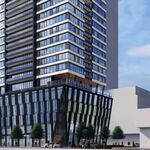JasonParis
Moderator
Proposed transit hubs may shun cars
GTA transportation agency considers terminals with amenities for buses, pedestrians and cyclists
Jan 28, 2008 04:30 AM
Tess Kalinowski
TRANSPORTATION REPORTER
What would Monday morning feel like if, instead of jumping in the car, you hopped on your bike and rode a couple of kilometres on a safe, treed path to the GO station?
What if you could then lock your bike in a secure storage facility, grab a shower and change your clothes in a clean, staffed locker room? Refreshed, you could then head to the WIFI lounge, order a coffee and check your email while you wait for your train.
That's the kind of transit terminal the Toronto area's transportation agency is considering for development around the region.
Metrolinx thinks more car-bound suburbanites might be persuaded to use transit if the stations were turned into mobility hubs that create a convenient and pleasurable experience (as opposed to the merely functional environment of so many current transit stations).
The hubs would be places where bus, pedestrian and bike traffic intersect with one or more forms of higher order transit such as subways, trains and streetcars.
They would offer upgraded, lighting, signage and weather protection, customer amenities and the best ones would be part of clusters of office, retail and residential development.
"I'm hopeful people will see the advantage of having more really accessible places in the region where you have a combination of good transit and quite a substantial amount of development," said Joe Berridge, a consultant with Urban Strategies Inc. who has been developing the concept for Metrolinx.
But the vision Berridge describes would mean changes in the way stations and the land surrounding them are used.
Existing transit hubs tend to be surrounded by vast parking lots, he said.
Those sprawling car parks would have to give way to paid parking structures that give priority to higher occupancy vehicles.
The acres of parking that surround many suburban transit stations discourage riders from walking or biking to their stop even if they live or work within 5 kilometres.
That land would be better used to build homes and offices that have been located near major 400-series highways.
To work, these mobility hubs would have to be built at the same time rail systems and bus services are expanded, and pedestrian and bike amenities are introduced so people truly feel they have an option, said Berridge.
He suggests that several hub sites be identified and developed to prove their effectiveness.
One suggested site could be an area north of Eglinton Ave. near Renforth Dr. near the airport that will eventually "be a knuckle on the transport system," said Berridge.
It's the spot Mississauga's planned bus rapid transit and the TTC's new Transit City light rail line would intersect and it could draw people from the high-occupancy vehicle lanes planned for nearby Highway 427.
The Oakville GO station, Mississauga City Centre, the Vaughan Corporate Centre, Markham Centre and Langstaff Rd. at Yonge St. are already in varying stages of development but have good potential as mobility hubs, said Berridge.
"If you think about suburban New York, London and Paris. Around those suburban rail stations, you get those clusters (of retail) where you can pick up groceries, a newspaper or flowers," he said.
Mobility hubs would also facilitate another trend Metrolinx wants to kick-start – more active transportation.
The agency is discussing ways in which biking and walking could be seen as functional rather than purely recreational activities. Building safe, well-lit routes for pedestrians and cyclists would encourage that shift, said Brian Hollingsworth, a Metrolinx consultant.
In addition to lowering greenhouse gasses, active transportation would make us healthier and reduce health care costs, he said.
There are 1.5 million trips of less than 30 minutes in the Toronto area that could be made by active transportation, he said. The discussions of mobility hubs and active transportation are among a series of green papers Metrolinx is releasing before it embarks on public consultations for its regional transportation plan, expected to be drafted by the spring.
GTA transportation agency considers terminals with amenities for buses, pedestrians and cyclists
Jan 28, 2008 04:30 AM
Tess Kalinowski
TRANSPORTATION REPORTER
What would Monday morning feel like if, instead of jumping in the car, you hopped on your bike and rode a couple of kilometres on a safe, treed path to the GO station?
What if you could then lock your bike in a secure storage facility, grab a shower and change your clothes in a clean, staffed locker room? Refreshed, you could then head to the WIFI lounge, order a coffee and check your email while you wait for your train.
That's the kind of transit terminal the Toronto area's transportation agency is considering for development around the region.
Metrolinx thinks more car-bound suburbanites might be persuaded to use transit if the stations were turned into mobility hubs that create a convenient and pleasurable experience (as opposed to the merely functional environment of so many current transit stations).
The hubs would be places where bus, pedestrian and bike traffic intersect with one or more forms of higher order transit such as subways, trains and streetcars.
They would offer upgraded, lighting, signage and weather protection, customer amenities and the best ones would be part of clusters of office, retail and residential development.
"I'm hopeful people will see the advantage of having more really accessible places in the region where you have a combination of good transit and quite a substantial amount of development," said Joe Berridge, a consultant with Urban Strategies Inc. who has been developing the concept for Metrolinx.
But the vision Berridge describes would mean changes in the way stations and the land surrounding them are used.
Existing transit hubs tend to be surrounded by vast parking lots, he said.
Those sprawling car parks would have to give way to paid parking structures that give priority to higher occupancy vehicles.
The acres of parking that surround many suburban transit stations discourage riders from walking or biking to their stop even if they live or work within 5 kilometres.
That land would be better used to build homes and offices that have been located near major 400-series highways.
To work, these mobility hubs would have to be built at the same time rail systems and bus services are expanded, and pedestrian and bike amenities are introduced so people truly feel they have an option, said Berridge.
He suggests that several hub sites be identified and developed to prove their effectiveness.
One suggested site could be an area north of Eglinton Ave. near Renforth Dr. near the airport that will eventually "be a knuckle on the transport system," said Berridge.
It's the spot Mississauga's planned bus rapid transit and the TTC's new Transit City light rail line would intersect and it could draw people from the high-occupancy vehicle lanes planned for nearby Highway 427.
The Oakville GO station, Mississauga City Centre, the Vaughan Corporate Centre, Markham Centre and Langstaff Rd. at Yonge St. are already in varying stages of development but have good potential as mobility hubs, said Berridge.
"If you think about suburban New York, London and Paris. Around those suburban rail stations, you get those clusters (of retail) where you can pick up groceries, a newspaper or flowers," he said.
Mobility hubs would also facilitate another trend Metrolinx wants to kick-start – more active transportation.
The agency is discussing ways in which biking and walking could be seen as functional rather than purely recreational activities. Building safe, well-lit routes for pedestrians and cyclists would encourage that shift, said Brian Hollingsworth, a Metrolinx consultant.
In addition to lowering greenhouse gasses, active transportation would make us healthier and reduce health care costs, he said.
There are 1.5 million trips of less than 30 minutes in the Toronto area that could be made by active transportation, he said. The discussions of mobility hubs and active transportation are among a series of green papers Metrolinx is releasing before it embarks on public consultations for its regional transportation plan, expected to be drafted by the spring.




